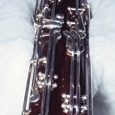Bassoon students sometimes struggle with getting the notes A3 through D4 to speak clearly and cleanly when articulated. Even with the appropriate amount of air pressure and a correct embouchure, the sound preceding the note can be rough and uneven.
Bassoon instructors often prescribe a traditional technique called flicking to cure notes that crack when articulated. Flicking involves the simultaneous pressing and releasing of a left hand thumb key when one of these troublesome notes is articulated. Synchroniza-tion of tongue, air pressure, and thumb key flick must occur for the note to speak cleanly, and in technically difficult passages, flicking is almost impossible for developing students to master. In many cases, a student may give up on flicking altogether, settling for the rough sound that occurs when these notes are articulated.
There is an alternative to flicking called venting, for which bassoonists depress one of the left-hand thumb keys for the duration of the note. When I start a beginning student on bassoon or encounter a student who struggles with flicking, I teach the fingerings for A3-C4 to include the thumb keys. Usually, the most troublesome notes are A3 and Bb3, so I especially enforce venting with these notes. Venting is especially helpful when a student has a fast tongued passage in this range. Instead of flicking each time a note is articulated, the student can hold a single thumb key while tonguing these notes. Immed-iately, the sound is much cleaner, but beware that this may not work for instruments in poor condition or for older, obscure models of bassoon.
Counterclockwise from the whisper key, the left thumb bassoon keys are whisper, C#, high A, high C, high D (not all bassoons have this key), low Bb, low B, low C, low D. For A3 and Bb3, vent the high A key. Use the high C key for B3 and C4 and as a universal vent key in fast technical passages. If the instrument has a high D key, use it to vent D4.
I also introduce using a vent fingering for D4 if a student has problems with the note speaking cleanly. However, some bassoons are not equipped with a high D key. If this causes a problem, have students use more air pressure, employ a firmer embouchure (round tension, as opposed to biting tension), and move the reed farther into the mouth to improve the D’s response. Also, make sure the bocal’s vent hole is clean.
For most bassoons, thumb keys will alter the pitch of A3 through D4, and a tiny pitch fluctuation from flicking can become a drastic tuning change when venting. This is most noticeable in long notes. Students who encounter tuning problems should adjust by changing the tongue’s height or the amount of space in the back of the mouth. Additionally, students should play these notes as long tones with a tuner to practice stabilizing and sustaining them while holding down the thumb keys. With practice, students can improve the altered pitch of vented notes.
Students who practice venting will be able to play these usually troublesome notes cleanly when articulated. If they already know how to flick, this will give them another tool to fix their sound and avoid rough, barky-sounding notes.






